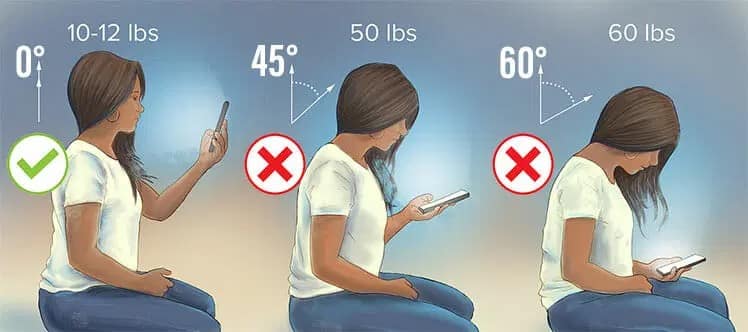Most people that are on their smartphones are looking down with their head bent forward. This has created a new syndrome called Tech Neck!
On average, a person will spend several hours on their phone. For our Canadian teenagers, this number is even higher.
Resource: Text Neck Syndrome in Children and Adolescents
82% of Canadian citizens report that they check their phone at least once every hour. many owners check or use their smartphone 6 times per hour on average – or about every 10 minutes.
In 2023, Physiopedia estimates the total number of global smartphone users to reach 6.8 billion. Given the global population to reach just over 8 billion, 8 in 10 people will be equipped with a smartphone (85%).
Tech Neck is a new name for neck pain also known as Upper Cross Syndrome. Upper Cross Syndrome is often caused by bad posture and is indicated by rounded shoulders, head in front of the body and a curve in the neck and upper back leading to the tightening of pectoral and neck muscles. The neck, shoulder, and upper back joints becoming restricted.
The average adult head weighs 10-12 pounds, supported by the neck’s bony structures, muscles, ligaments, and tendons. When your head is tilted forward and looking down, the weight of your head places 50-60 pounds of force on the neck.
Symptoms of Tech Neck
The symptoms can have a negative effect on our daily living. The pain can build up over time. It may go away for a while but then appear again over time. The pain can be a dull ache or a sharp pain that moves from the neck down through the shoulders and back and possibly into the arms.
Symptoms may include:
- Pain and aches in the lower neck, shoulders, and upper back
- Sharp pain in one area
- Headaches
- Reduced mobility in the neck, upper back, and shoulders
- Increased pain when tilting the head forward and looking down to tex
- Jaw pain from misalignment of the cervical spine
- Tingling pain and numbness in the arms and hands from spinal nerve irritation and inflammation
- difficulty maintaining good posture
Treatment
Raise your phone and try to keep your head in a neutral position with ears directly above the shoulders. Take breaks from your phone, even for a few minutes every hour, and stretch often.
Neck pain can make exercise more challenging but keeping active when possible is typically good for the neck. Yoga is a great way to stretch.
Healthline lists several stretching exercises suggested by chiropractors, such as the exaggerated nod, which counterbalances the downward/forward head position by pulling your shoulders down and back and increasing neck mobility.
6 Chiropractor-Approved Exercises to Fight Text Neck
If the pain worsens or persists, you can seek treatment from a chiropractor.
Dr Natasha Hayden is a pediatric and prenatal chiropractor that is passionate about helping her community discover just how good their bodies are designed to feel, so they can do more of what they love.
Your health goals are within reach with the support of our team.



